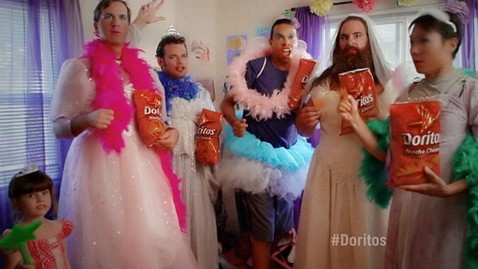Super Bowl Calorie Count: What If You Ate Everything You Saw Advertised?

Credit: Doritos/ABC News
Between keeping track of the score, the clock, the down and yardage, the Super Bowl involves a lot of number-watching, but what viewers tend not to count during the wing-munching, chip-chomping free-for-all are calories.
And with ads full of taco-loving senior citizens and a violent (screaming) goat who really loves his Doritos, it feels more natural to laugh it off and take another bite - maybe even do a snack run for tacos and Doritos.
"There's definitely a lot of evidence that advertising is extremely persuasive," said Sara Bleich, a health policy professor at Johns Hopkins Bloomberg School of Public Health. "The Super Bowl is sort of a free license for gluttony across all demographic groups.
Bleich compared the Super Bowl to Thanksgiving, and said she guesses people consume "thousands" of calories before the best team wins.
So what would happen if you ate one serving of everything you saw advertised? I wanted to find out, so I came up with a pseudo-scientific methodology for counting calories. For example, since the M&Ms commercial only contained the red guy, I included the calories for plain M&Ms instead of peanuts.
It's science.
Sort of.
I only included one serving size of each food item advertised, such as one coke, one beer or one handful of chips, and I tried to come up with pretty fair meals for the fast food restaurants. Still, Bleich said serving sizes probably weren't the most realistic way to go.
"People in general have a very poor sense of serving sizes," she said. "The bigger the bag of Doritos, the more they're going to eat - sometimes 30 or 40 percent more."
Regardless, here's the first quarter:
| M&Ms (plain) | 236 |
| Doritos | 137 |
| Pepsi Next | 60 |
| Budweiser Black Crown | 180 |
| Coca Cola | 136 |
| Oreos | 160 |
| FIRST QUARTER TOTAL | 909 |
It clocks in at 909 calories - half a normal person's daily caloric allowance - in the first half hour of the game.
On the bright side, this fictional person would still have consumed fewer calories than the goat in the first ad who ate his 156 th bag of Doritos in the bathroom in the middle of the night.
Here's the second quarter:
| Bud Light | 110 |
| Doritos | 137 |
| Milk (a cup of 2 percent) | 122 |
| Coca Cola | 136 |
| Subway (Sweet Onion Teriyaki Footlong) | 760 |
| Taco Bell (Cherry Limeade Sparkler (150), Steak Chalupa (350) and black beans and rice (200) | 700 |
| SECOND QUARTER TOTAL | 1965 |
I noticed this quarter had fewer snack ads and more meal ads, which makes sense because people probably want to eat more than chips and M&Ms during the four-hour game. Why not try to prompt them to make a fast food run?
Then, there was an ad for milk. This follows last year's Oikos yogurt ad, which shocked a lot of people because the product wasn't junk food. I added the 122 calories in a cup of 2 percent milk because whole or skim just felt too extreme. See? Science.
After that, it was time for the Beyonce halftime show, which was sponsored by Pepsi and therefore had a Pepsi ad before and after. I added two more 12-ounce servings of cola.
| Pepsi | 136 |
| Pepsi | 136 |
| HALFTIME TOTAL | 272 |
Not long after Beyonce left fans dazzled, half the stadium was plunged into darkness during the half hour power outage. The last half of the game featured ads for pistachios, more beer, more soda and more Subway sandwiches.
At some point during the confusion, @Oreo tweeted an on-the-fly ad about dunking in the dark. It could be another 160-calorie serving of cookies, but I left it out because it wasn't on TV.
Jessica Bennett, a dietitian at Vanderbilt University Medical Center, said she noticed more food advertised in the first half of the game.
"I would say that because people could theoretically get some of those products at halftime, I think that's part of the draw for that [kind of advertising strategy]," said Bennett, adding that she also has a background in marketing.
Click here to watch the best Super Bowl ads.
Here's the third quarter:
| Bud Light | 110 |
| Pistachios | 330 |
| Budweiser | 149 |
| Mio Fit | 0 |
| Pepsi | 136 |
| Subway | 560 |
| THIRD QUARTER TOTAL | 1285 |
That reminds me, since nutrition information, including calories, isn't required on beer labels, I had to make educated guesses on those. I used numbers from the National Institutes of Health alcohol calorie calculator.
Here's the last quarter:
| Beck's | 149 |
| Soda Stream (a machine, one serving of cola) | 136 |
| FOURTH QUARTER TOTAL | 285 |
So what's the grand total if we're counting only single serving sizes and relatively conservative meals in this not-so-scientific project?
4716 calories!
Bleich's first response was "wow!"
"That is more than double the recommended amount for the average adult for an ENTIRE day (2000 calories) and it was only over a four-hour period," she wrote in a follow-up email.
Bleich said that since people usually don't finish their food, they throw away 25 percent on average.
"Even taking that into account, which would give you 3,537, it is still much higher than the recommendation for an entire day," she said.
Since a pound of weight gain is equal to about 3,500 calories, this fictional person would have gained at least a pound during the four-hour game, Bennett said.
"And most people were sitting on the couch," she said. "So they probably weren't burning many calories."